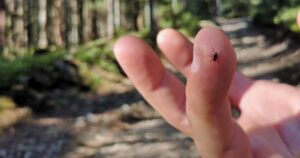icks are small, parasitic insects that feed on the blood of humans and animals. While they may seem like a minor nuisance, ticks can carry serious diseases such as Lyme disease and Rocky Mountain spotted fever. If you discover a tick in your home, it’s essential to act quickly and follow proper removal and prevention techniques to protect yourself and your family.
Why Are Ticks a Concern?
Ticks are known to thrive in wooded and grassy areas, but they can also enter homes by attaching themselves to pets, clothing, or even furniture. Once inside, they may linger in warm, dark spaces. While not all ticks carry diseases, it’s always best to exercise caution when dealing with them.
Ticks can spread illnesses through their bites, and some symptoms of tick-borne diseases include:
Fever and chills
Fatigue and muscle aches
Skin rashes
Joint pain
Since prevention is key to avoiding potential health risks, knowing how to properly handle and remove ticks is crucial.

How to Identify and Isolate the Problem
The first step when finding a tick inside your home is to determine the type of tick and isolate the area where it was discovered. Common household ticks include:
Black-legged (Deer) Tick – Known to spread Lyme disease.
American Dog Tick – Can transmit Rocky Mountain spotted fever.
Brown Dog Tick – Often found in homes and kennels, this tick can complete its life cycle indoors.
If you locate a tick, ensure that children and pets stay away from the area until the tick is safely removed.
Protect Yourself Before Handling a Tick
Before attempting to remove or handle a tick, take the following safety precautions:
Wear gloves – Avoid direct contact with the tick to prevent possible infections.
Use tweezers – Fine-tipped tweezers work best for safe tick removal.
Wear long-sleeved clothing – Covering your skin reduces the risk of tick bites.
How to Safely Remove a Tick
Proper tick removal is essential to ensure that no part of the insect remains embedded in the skin. Follow these steps:
Use fine-tipped tweezers – Grab the tick as close to the skin’s surface as possible.
Pull slowly and steadily – Avoid twisting or jerking, as this may cause the tick’s mouthparts to break off.
Dispose of the tick – Submerge it in alcohol or flush it down the toilet.
Clean the bite area – Use soap and water or antiseptic wipes to disinfect the area.
Cleaning Your Home After Tick Removal
Once the tick has been removed, it’s important to clean and disinfect your home to prevent further infestations.
Wash all bedding and clothing – Use high heat to kill any remaining ticks.
Vacuum thoroughly – Pay close attention to carpets, rugs, and hidden crevices.
Use tick repellents – Natural remedies like essential oils (eucalyptus or peppermint) can help deter ticks.
Final Thoughts
Ticks are more than just a nuisance—they can pose serious health risks if left unchecked. By following the right removal and cleaning methods, you can keep your home safe from tick infestations. Prevention is always the best strategy, so taking proactive steps to keep ticks out of your living space is essential.
If you found this guide helpful, share it with your family and friends to help spread awareness about tick safety and prevention!





